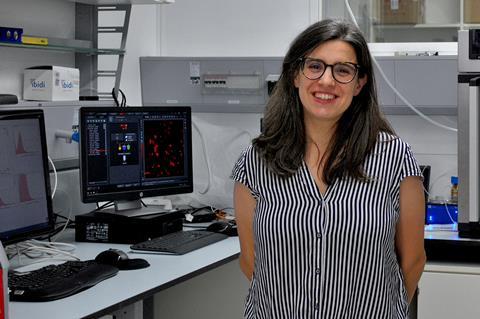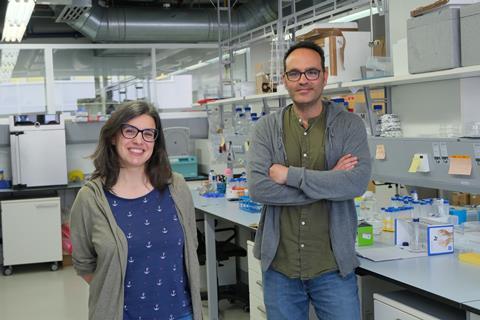
‘It was kind of crazy,’ laughs Beatriz Pelaz as she describes her colourful academic journey. ‘But I did it, and it worked out.’
‘Worked out’ is certainly an understatement – this year Pelaz was awarded the Royal Spanish Society of Chemistry’s Young Researcher prize in recognition of her outstanding early career trajectory. In 2017 Pelaz and Pablo del Pino co-founded the BioNanoTools group at CIQUS, Spain, one of several co-led research groups within the department. The group includes researchers from across the sciences and develops smart nanomaterials for medical and biological applications. However, this is a far cry from where Pelaz began.

‘I was actually doing a master’s degree in organometallic chemistry,’ she remembers. ‘But I became more interested in the biological side.’ Pelaz then made a bold decision: she moved to Zaragoza to begin a biochemistry undergraduate degree at the same time as starting a PhD. Here, her work with Jesús Martínez de la Fuente, researching carbohydrate synthesis for the biofunctionalisation of nanoparticles, introduced Pelaz to nanotechnology. ‘The field was totally new for me at the time, and also very multidisciplinary. I was really excited by it.’
Zaragoza was also where she met del Pino, a biophysicist who joined the de la Fuente group. After five years of working together for different supervisors across Europe, the pair decided to set up a joint research group, combining their expertise to work towards a shared goal. ‘People find it difficult to understand why we wanted to have equal positions in a single group,’ comments Pelaz. ‘From time to time we get pressured to separate the groups, but we believe we are more efficient when we work together.’
My favourite thing about the group is that we are really gathering people with different backgrounds
Fundamentally, nanotechnology comes down to a matter of size – at the nanometre scale, many materials exhibit interesting size-dependent properties including optical, electromagnetic and fluorescence characteristics. Importantly for the BioNanoTools group, nanomaterials are also at the correct size to interact directly with biological systems such as cells, proteins and antibodies. ‘The challenge in bionanotechnology is to get a truly efficient nanomaterial – you design a material to perform an action and you want this action to happen in a very specific area,’ explains Pelaz. ‘The overall aim of our group is to make smart, efficient, remote-controlled nanomaterials that can be switched on or off using external stimuli.’
Collaborative mindset
With such an interlinked field, the advantage of diverse academic backgrounds is obvious. Pelaz and del Pino share responsibility for all group projects but drive different research lines as fits their skill set. This collaborative mindset is mirrored throughout the group where students are encouraged to develop skills beyond their speciality. ‘We have people from many academic backgrounds, and I think this is very enriching,’ says Pelaz. ‘Different employees will have points of view, which are providing solutions from different perspectives.’

It is perhaps this bedrock of varied knowledge and experience that gives the team both the confidence and skills to tackle bionanomaterials from so many angles. One of the largest research lines in the group focuses on designing biomimetic nanocomposites for drug delivery. Antibodies are loaded into a cell-derived plasmonic nanomaterial, which is doped with gold nanorods. The team allows these composite nanomaterials to internalise into living cells where they remain dormant until activated by a specific wavelength of light. ‘By combining these two abilities, the biocompatible plasmonic properties and the thermal abilities of the gold nanorods, which absorb light, we can induce controlled release of the antibodies,’ says Pelaz.
But like all researchers, Pelaz also has a favourite project. Using DNA origami, she hopes to create nanoprinters that can functionalise the surface of nanomaterials with exquisite control. DNA strands can be folded with almost atomic precision to form highly specialised 3D structures that the team is trying to adapt to print ligands onto the surface of nanoparticles, for example, to mimic the protein patterns expressed on viral membranes. ‘This is a very fundamental study,’ explains Pelaz. ‘I would like to understand how the spatial distribution and number of ligands can determine the biological fate of nanomaterials.’ One year in, this project is still at a very early stage, but the team hope that it will ultimately help them design more efficient nanomedicines.
The BioNanoTools group certainly seems like a vibrant and stimulating research environment. But whilst the science is obviously important, it’s clear that the people define the group for Pelaz. ‘For us, it’s critical that people feel comfortable in the lab, that they learn, but also enjoy it,’ she smiles. ‘I think my favourite thing about the group is that we are really gathering people with different backgrounds. That for me is great because as a bunch of chemists alone, we would not be capable of achieving or developing the approaches that we are currently working on.’
Combining expertise to develop remote-controlled nanomaterials | Research & Latest News Update
Combining expertise to develop remote-controlled nanomaterials | Research & More Live News
All this news that I have made and shared for you people, you will like it very much and in it we keep bringing topics for you people like every time so that you keep getting news information like trending topics and you It is our goal to be able to get
all kinds of news without going through us so that we can reach you the latest and best news for free so that you can move ahead further by getting the information of that news together with you. Later on, we will continue
to give information about more today world news update types of latest news through posts on our website so that you always keep moving forward in that news and whatever kind of information will be there, it will definitely be conveyed to you people.
Combining expertise to develop remote-controlled nanomaterials | Research & More News Today
All this news that I have brought up to you or will be the most different and best news that you people are not going to get anywhere, along with the information Trending News, Breaking News, Health News, Science News, Sports News, Entertainment News, Technology News, Business News, World News of this made available to all of you so that you are always connected with the news, stay ahead in the matter and keep getting today news all types of news for free till today so that you can get the news by getting it. Always take two steps forward
Credit Goes To News Website – This Original Content Owner News Website . This Is Not My Content So If You Want To Read Original Content You Can Follow Below Links
